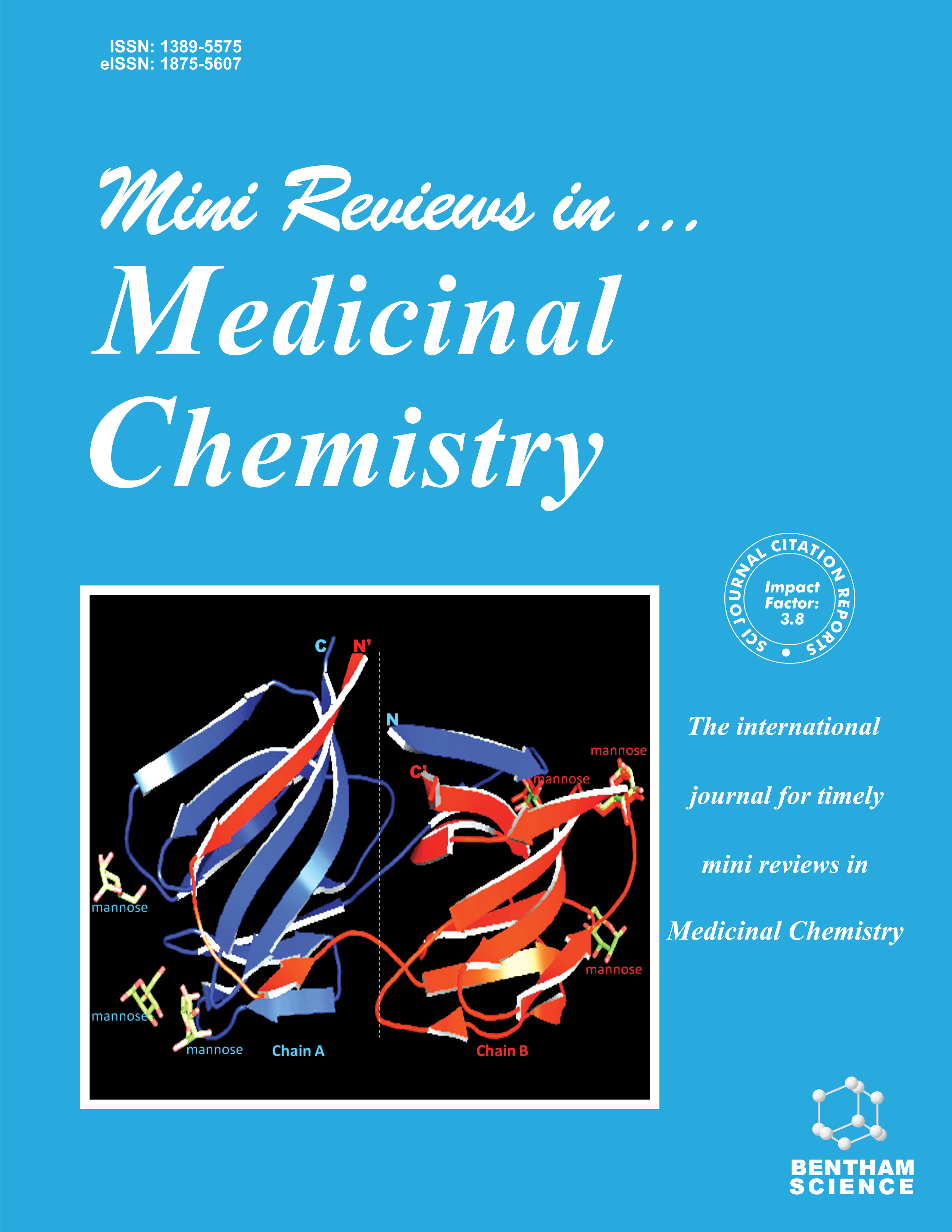Mini Reviews in Medicinal Chemistry - Current Issue
Volume 25, Issue 17, 2025
-
-
Antimicrobial Activity of Naturally Occurring and Semi-Synthetic Chlorinated Compounds
More LessAuthors: Kowsar Marefat, Mina Saeedi and Mahnaz KhanaviIntroductionObjectiveAntimicrobial resistance (AMR) has become a global controversial issue, making conventional treatments less effective. Hence, the design and development of new and efficient antimicrobial agents are on the researchers’ agenda to reduce death rates and health care costs. In this regard, chlorine-containing compounds have been the center of attention. This review highlights the antimicrobial potential of chlorine-containing natural and semi-synthetic compounds, aiming to identify versatile candidates effective against microorganisms.
MethodsThe literature was comprehensively surveyed using Google Scholar, Web of Science, Scopus, and PubMed, focusing on studies published since 2016, focusing on the antimicrobial properties of natural and semi-synthetic chlorinated compounds.
ResultsNatural chlorinated compounds have shown remarkable antimicrobial activity, generally more potent than their semi-synthetic counterparts.
DiscussionThe strong activity against resistant strains like MRSA underlines their therapeutic potential in addressing pressing clinical challenges. Nature-derived scaffolds serve as a promising foundation for the development of novel antimicrobial agents.
ConclusionSeveral naturally occurring compounds have proven more effective than their semi-synthetic derivatives, making them attractive candidates for addressing the growing threat of AMR.
-
-
-
Applications and Prospects of Computer-aided Drug Design for the Development of 99mTc-labelled Isonitrile-carbohydrate Derivatives for Tumour Imaging
More LessAuthors: Zuojie Li and Junbo ZhangEffective and accurate drugs for imaging and tumour diagnostics are essential for the early detection of diseases and the development of treatment plans. 18F-2-Fluoro-2-deoxy-D-glucose ([18F]FDG) is the most widely used molecular tumour probe for positron emission tomography (PET) in clinical applications. However, no comparable molecular probes have been approved for single-photon emission computed tomography (SPECT) in clinical diagnostics. In recent years, significant advancements have been made in tumour probes containing 99mTc-labelled isonitrile-glucose molecules, which exhibit high specificity and sensitivity for tumour diagnosis, providing clear SPECT image contrast and diagnostic performance comparable to [18F]FDG. Based on research from our group and previous studies in the literature, the primary objective of this perspective is to investigate the structural design, molecule–target interactions, and protein–ligand complex energies of 99mTc-labelled isonitrile-carbohydrate tumour probes from the perspective of computer-aided drug design (CADD). The findings presented here provide a reference and motivation for the development of novel 99mTc-labelled carbohydrate-based tumour probes.
-
-
-
Current Developments in the Pharmacological Activities and Synthesis of Carbazole Derivatives
More LessAuthors: Gersy Marie Joelle Oba, Rakesh Sahu, Kamal Shah, Deepika Paliwal, Ashok Kumar Sah and Aman ThakurThe growing prevalence of multidrug resistance and its detrimental effects pose a significant threat to public health, which is one reason for the current interest in the introduction of novel agents. To combat this adverse effect and drug resistance, numerous drugs have been developed over time, and their safety is still being evaluated; derivatives or medications based on the carbazole moiety are one of the key contributors. Therefore, this review explores carbazole-based derivatives as possible drugs to treat Alzheimer's, diabetes, inflammation, cancer, and many more, along with their synthetic schemes, SARs, and activity. Some of the carbazole-based drugs available in the market and under clinical trials are also tabulated. By integrating this insight, describe how these compounds are being reinvented as targeted therapeutic agents. This comprehensive analysis is designed to guide researchers in developing next-generation drugs to address various challenges and leverage the unique pharmacological properties of carbazole-derived drugs.
-
-
-
Therapeutic Potential of Underexplored Phytoconstituents Targeting Molecular Pathways in Breast Cancer Subtypes
More LessBreast cancer is a heterogeneous disease consisting of several molecular subtypes, such as Hormone Receptor-positive (HR+), Human Epidermal Growth Factor Receptor 2-positive (HER2+), and Triple-Negative Breast Cancer (TNBC). Although a lot of success has been realized in targeted agents, there still remain significant problems, including resistance to drugs, toxicity related to treatment, and few therapeutic possibilities for aggressive subtypes. Confronting such limitations requires complementary treatment approaches with better efficacy and safety profiles. Phytoconstituents from natural sources have emerged as potential therapeutic agents due to their multitargeting activity, good safety profile, and capacity to evade drug resistance. These bioactive molecules, such as flavonoids, alkaloids, terpenoids, and saponins, possess various mechanisms of action, including modulation of cell cycle regulators, induction of apoptosis, inhibition of angiogenesis, suppression of metastasis, and regulation of critical oncogenic signaling pathways. Their interference with several cancer pathways gives them a holistic strategy for breast cancer therapy. This review offers an in-depth examination of new phytoconstituents that target the molecular basis of various subtypes of breast cancer. It also highlights their scope for integration into traditional paradigms either as monotherapy or in combination with current therapies to increase therapeutic impact with the least adverse effects. Through the clarification of their mechanisms of action and therapeutic advantages, this review promotes the ongoing pursuit of phytoconstituents as potential contenders in contemporary oncology, providing novel targets for the control of breast cancer and enhanced patient care.
-
Volumes & issues
-
Volume 25 (2025)
-
Volume 24 (2024)
-
Volume 23 (2023)
-
Volume 22 (2022)
-
Volume 21 (2021)
-
Volume 20 (2020)
-
Volume 19 (2019)
-
Volume 18 (2018)
-
Volume 17 (2017)
-
Volume 16 (2016)
-
Volume 15 (2015)
-
Volume 14 (2014)
-
Volume 13 (2013)
-
Volume 12 (2012)
-
Volume 11 (2011)
-
Volume 10 (2010)
-
Volume 9 (2009)
-
Volume 8 (2008)
-
Volume 7 (2007)
-
Volume 6 (2006)
-
Volume 5 (2005)
-
Volume 4 (2004)
-
Volume 3 (2003)
-
Volume 2 (2002)
-
Volume 1 (2001)
Most Read This Month Most Read RSS feed


